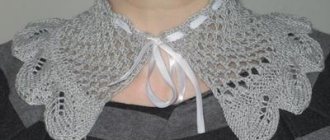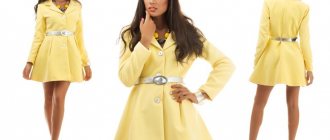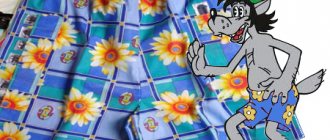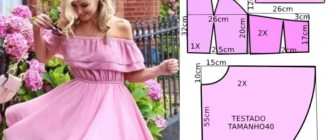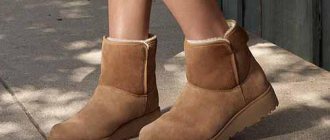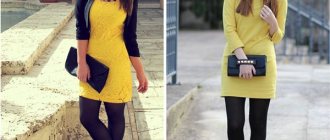Bolero is an original item of women's wardrobe. Initially, it was an element of traditional Spanish clothing. And in the 19th century it became widespread throughout Europe.
Now this stylish cropped jacket is back in fashion. With its help, you can create new looks with already boring dresses, sundresses or tops.
There are several options for bolero: made of knitwear, lace or fur, artificial or natural. It is suitable for both going out and everyday office style. The stores offer various versions of this wardrobe item. However, it is difficult to choose the right color and style that will look beautiful on your figure.
There is an exit! You can sew a bolero with your own hands. We'll tell you how to do this.
How to sew a bolero with your own hands?
Every magazine that offers patterns and detailed descriptions lays out the technique for sewing this product. This includes Burda Moden, Chic, Atelier and many others. If you don’t have a magazine at hand, and especially if you want to sew it according to your own measurements, you can build the base yourself. And then change it - add frills along the bottom or along the entire perimeter, remove or add any elements.
Below is one guipure bolero pattern. The numbers are average. You rely on your own measurements.
- Back length.
- Chest circumference.
- The length of the sleeve.
- Wrist circumference.
You can calculate the half (for Og and Oz) and quarter measurements (for Og) in advance. Construct a drawing by substituting numbers from your own measurements.
For sewing you will need fabric (Di + Dr + hem), scissors, needle, pins, thread, satin bias tape.
- Transfer the drawing to the cut.
- Cut out taking into account allowances and cut.
Allowances along the bottom of the product and the outer edge can be ignored, since they will be processed with bias tape.
- Connect the shoulder seams of the shelves to the backs. Sew.
- Sew the unstitched sleeve into the open armhole.
- Sew the sleeve seam and the side seam in one seam.
Don't forget to overlock or zigzag all the allowances. Better yet, treat them with bias tape - this will turn out more neatly and professionally.
- Iron the item.
- Fold the bias tape in half lengthwise and press the fold line.
- Stitch bias tape around the entire perimeter of the bolero.
- Sleeves can be hemmed without bias tape by turning the seam allowance twice to the wrong side.
Sewing a guipure bolero with your own hands turned out to be quick and easy. Now we can say that clothes for the holiday have a twist and have a finished look.
This is interesting: Bolero pattern for girls (aged 5-10 years)
How to model a bolero pattern
Pattern modeling involves drawing up a drawing of the future product. To implement it, you need to know the approximate model of the jacket and take measurements from the model on which it will be sewn. You need to know the girth of your neck, chest, and waist. You should also immediately decide on the length of the product. The bolero can be up to the chest, navel or waist.
Classic version of the bolero
The drawing is made in the following sequence:
- First, a vertical straight line is drawn on paper, from which the future pattern will be built. Line length = product length. When making a drawing according to measurements, you need to add 1-2 centimeters on each side for seams and allowances.
- To the drawn straight line, 2 lines are drawn perpendicularly horizontally, which in length correspond to the measurements of POG and POS. The parts are aligned along the side seams.
- After this, the back part is drawn. A vertical line is drawn from the chest line to the bottom of the product. To make the bolero fit, you can narrow it at the bottom by a few centimeters so that the product fits your figure.
- You need to draw a shoulder line from the level of the neckline. The sleeve is built in accordance with the model. If it is required, then a line is laid to the required length at a right angle.
You might be interested in this: Instructions for sewing a blouse with your own hands without patterns
Product diagram
What you need for work
To sew a bolero you need a minimum number of tools and materials, most of which everyone has in their home.
- Paper or tracing paper.
- Pencil and ruler.
- Textile.
- Needle and thread.
- Sewing machine.
- Scissors.
- Safety pins.
- Buttons and fasteners.
The material must be chosen depending on what you plan to combine this item of clothing with.
Advice! Guipure, satin and velvet are suitable for evening outings. For everyday use, knitwear, cotton or women's suit fabrics.
How to sew a soft fur cape yourself quickly and easily
A fur bolero symbolizes wealth and dignity. Therefore, this accessory should be present in the wardrobe of every fashionista. Models made of faux fur are suitable for everyday use, but for special occasions it is better to wear boleros made of natural fur.
The patterns for a short fur jacket are no different from regular ones. Here, too, the fronts can be round or straight, and the sleeves can be short or long.
Here is an example of a simple pattern from which you can sew a fur bolero.
Some tips for choosing natural fur:
- Inexpensive fur - silver fox, rabbit, fox.
- Mink is more expensive. But it is very pleasant to the touch.
- It is important to pay attention to the thickness of the fur. Not all sewing machines can sew thick material.
- When choosing a fur color, it is better to focus on your color type.
- Shades such as beige, gray, black, fawn look noble.
We sew a fur bolero in the same way as we do from fabric.
Variation on the theme of the cape
If we are sewing bolero from guipure, we suggest trying this model with a hood. You can wear it to any celebration. Its pattern is elementary - a circle and a rectangle.
- The circle is the cape itself. On one side you need to cut to the center. Cut a smaller circle in the center for the neck.
- The rectangle is the parts of the hood. Its smaller side is equal to ½ the circumference of the neck. You will need two such parts.
We cut out all the elements from guipure. We connect the parts of the hood and sew it into the neck. We process all allowances, outer edges with bias tape. You can sew on a ribbon or a button or a hook so that the cape stays on your shoulders without falling off.
The result is a luxurious model.
Bolero knitting for girls, 14 patterns with knitting patterns and descriptions, Knitting for children
Why do you think a bolero is needed? In fact, this is not the most functional clothing, but a bolero can become the highlight of your outfit or an elegant, and most importantly warm addition to a festive dress.
articles
A bolero is a cape with long or short sleeves. A short-sleeved bolero won't keep you warm in winter, but it will be just the highlight of your look. Boleros are usually worn with off-the-shoulder clothing. If it suddenly becomes cold or it is indecent to expose the upper parts of the body indoors, just put on a bolero and the problem is solved.
- made of fur (for special occasions: wedding, going to the theater, going to a restaurant)
- knitted openwork, using the Irish or ribbon lace technique
- made of thick fabric, like cropped jackets
- summer ones made of light fabric.
What to combine with
Boleros can be combined with absolutely all styles. The main thing is that the item fits your figure. The bolero looks ridiculous with tops with bare shoulders or oversized T-shirts/blouses (any size). Looks appropriate with fitted skinny trousers or jeans. A bolero of any cut fits perfectly on thin people if combined with skirts of any length and fitted blouses (tops, T-shirts).
If the jacket is decorated with furs or rhinestones, it is best to wear it with simple knee socks or fitted blouses. It should not be worn over ruffles or frills.
You might be interested in this: How to use old jeans to sew something
Advice! Overweight women with large breasts should avoid short jackets, because they already visually add volume.
Under the dress
Even a novice craftswoman can quickly sew a bolero with her own hands without a pattern. To do this, you need to be patient and attentive, because any work requires calmness and determination.
How to cut a bolero jacket
The bolero pattern for a dress without sleeves or with sleeves is made according to the same principle. After this you need to do the following:
- Fold the fabric evenly in half with the right side inward on a flat, hard surface (it is better to use a table or floor).
- The pattern is laid out on the fabric, pinned with needles and outlined with chalk or soap.
- After this, the parts need to be carefully cut out and swept away.
- Before stitching the product, you need to baste and measure (required).
How to sew a bolero without a collar
To make a product without a collar, draw a slightly different pattern: the front, back and sleeves are on the same level. Even a beginner can easily make this style. It does not require any special sewing skills. Using the pattern, fabric parts are cut out and sewn together at the seams. The top can be hemmed or finished with bias tape.
Bolero without collar
DIY T-shirt bolero
Many people are interested in how to sew a fashionable cotton bolero. This model can be easily altered from a regular T-shirt or T-shirt. Let's look at a few interesting styles that you can make with your own hands in a matter of minutes:
- Bolero with ruffles. A regular T-shirt or tank top will be useful for this. The product must first be cut to the required length. A cut is made in the middle and the edges are processed. You can leave them loose or make a lock or buttons. In this case, the bottom can be hemmed or ruffles or lace attached to it. It is better to use a stitching machine to ensure that the product is neat and durable.
With lace
- Bolero with laces can be made of cotton or jersey. The old T-shirt needs to be straightened and smoothed. Then a cut is made in the front center and around the neckline so that it can be used to make a tunnel for the lace. First, a mark is applied, then stitched on a machine. After this, the lace (or braid) is threaded through and the bolero is ready. You need to tighten it according to your figure, depending on the desired length of the product. If it is too long, the bottom can be trimmed a little, hemmed and stitched so that the product has an aesthetic appearance. This product can complement any dress for a girl.
You may be interested in this Instructions for embroidery on T-shirts with examples
Bolero with laces
The advantage of a T-shirt bolero is that you can make it yourself in a matter of minutes. This item is suitable for children and adult women. This does not require modeling, cutting and sewing skills and does not require making a drawing or pattern.
T-shirt bolero
Plush bolero
This item is perfect for an elegant dress. This is an original and warm accessory. Most often it is cut with sleeves, as it is designed for insulation during the cold season. The basis is plush, fur or eco fur. This model will require a lining. It can be made from any fabric. You also need to purchase braid for edging. The product is sewn according to a standard pattern, only it is advisable to make the sleeves long and one-piece. All seams are processed on a machine, the edges are turned.
This product is suitable for going out and for everyday wear. It looks good with a dress and jeans.
Long sleeve plush jacket
Bolero pattern with full sleeves
This style is available in any length. Fasteners can be made as desired. The peculiarity of the model is that the sleeve is cut out immediately, that is, it is cut out of the fabric along with the product, while standard sleeves are cut separately and then sewn on.
The pattern consists of three parts: a back and two front parts. This option is quite simple and free, like oversize. The item can be decorated with rhinestones, transfers or buttons. The product will suit a woman's delicate look, complement a dress or formal suit with a T-shirt or fitted blouse.
One-piece sleeve
You can see the process of cutting and sewing the product in more detail in the following video:
Knitted bolero for girls
The bolero is knitted by our readers, admire this beauty!
Knitted cape for girls
Hello needlewomen! I found a bolero cape on the Internet and decided to try knitting it. This is what happened. I used angora thread (100g/450m). Author Oksana Belioglo. Bolero knitting pattern:
Read more…
Knitted pink bolero for girls
A pink bolero for a girl is knitted. Bolero size: for 4 years. To knit a bolero you will need: 200 g of pink Scilla yarn (100% cotton, 105 m/50 g); knitting needles No. 4 and No. 4.5; 1 button. Double elastic: contrasting thread
Read more…
Knitted dress and bolero for girls
Size: for 6-8 years. You will need: “Azalea” yarn (30% cotton, 70% viscose, 330 m/1oo g) - 250 g yellow, 150 g light green, knitting needles No. 3 and 3.5, set of double needles No. 3. Knitted dress Samples matings:
Read more…
Knitted openwork bolero for girls
Openwork sleeves - boleros will definitely come in handy for your daughter on a cool summer evening or will serve as an excellent addition to an evening outfit.
Dimensions: 92/98 (104/110) 116/122. Knitting openwork sleeves (bolero) You will need: 150 (200) 200 g of white Candy yarn (100% Read more…
Knitted melange bolero with raglan sleeves
Bolero size: 2-2.5 years. To knit a bolero you will need: Angora fine print yarn (50% mohair, 50% nylon, ZOOm/50 g), knitting needles No. 2, thin satin ribbon. Bolero knitting density: 24 stitches x 34 rows = 10×10 cm. Basic patterns:
Read more…
Knitted cream bolero for girls
The main knitting is done on knitting needles with 2×2 elastic. The sweater pattern is a rectangle. Its width is equal to the width of the back plus 10-16 cm for the sleeves. The length is equal to the length of the back from the neckline to the hip line plus the width of the collar (10-12 cm). Number of loops
Read more…
This is interesting: Bolero pattern for a baby
Three children's crocheted boleros
The pineapple pattern is very versatile and is perfect for knitting baby clothes for girls. Today we offer 3 children's ballerinas, the patterns for which are based on this pattern. It is easy to crochet a children's bolero, starting from the yoke. Below are patterns of bolero for girls.
A bolero made of melange cotton yarn looks beautiful; it will be an excellent addition to a simple plain summer dress.
A bolero with long sleeves is knitted differently - we knit the back, front, sleeves, and connect the parts.
Based on the same pattern, you can make an openwork sleeveless vest; it will also decorate your princess’s wardrobe.
Source: https://knits4kids.ru/tri_detskih_bolero_kruchkom/
Master class: how to sew a guipure bolero without lining
So, we have guipure on a knitted base. From it we cut out the details: shelves, backs, sleeves, hems, back neck facing.
From the satin we cut the base using the same details: shelves, back, hem and back neck facing.
We reinforce the details of the hems and the satin back facing with an adhesive pad.
Then we place the guipure cut parts with the wrong side on the front side of the satin parts and baste them.
The satin will serve as a kind of lining and at the same time as a background.
We connect the side and shoulder seams of the bolero, the seams of the sleeves, the hem with the facing of the back neck. Iron all seams.
We fold the hems with the product with the right sides inward, aligning the middle of the back neckline and shoulder seams, as well as all the cuts and grind them.
We cut the seam close to the stitching, iron it, turn it over the face and sweep it out. We baste and hem the hem allowance for the bottom, secure the facing at the shoulder seams and a little along the back, remove the basting. We iron everything again.
We bend the sleeves, hem them, iron them.
We sew in the sleeves, seating them along the edges, sew them in and slightly iron the fit. Attach the shoulder pads.
Crochet bolero for women
An openwork bolero goes beautifully with summer clothes, such as sundresses and knitted skirts. A summer bolero can be complemented with ballet flats or sandals.
Crochet bolero (shrug), Olga's work
The bolero is made on the basis of ribbon lace. Spanish yarn Katia capri was used (skein 50 g, thread length 125 meters) Hook 2.5. Bolero size 42. It took 3 skeins.
Ribbon selected:
The video should load here, please wait or refresh the page.
How to knit, description
- We knit a ribbon of the required length (determined during fitting). Wash and style as follows.
- Then we knit the insert according to the pattern.
- Then we sew the insert to the tape.
- The result is this bolero. We tie the armhole line with small shells.
Crochet bolero Bruges spring
Bolero “Bruges Spring” Technique: crochet Size: 46-48 Materials: this bolero is knitted Yarn: Vita cotton VEGA composition: 65% viscose, 35% cotton color: yellow 5356, green 5364 Source of model description: model Natalia Sukhikh, MOD magazine No. 2(548) My changes: different collar, ties on the sleeves,
Read more…
Bolero Fuchsia crochet
Bolero "Fuchsia". Technique: crochet. Size: 46-48. Materials: this bolero is knitted Yarn: Magic MICROFIBRE composition: 100% microfiber, color: fuchsia - 3445. Source of model description: RANKDARBIAI magazine 2008 An elegant bolero is knitted using the Bruges lace technique, the base is decorated with an openwork mesh (my modification of the original model) and floral motifs. Crochet bolero patterns
Read more…
Shrug bolero Julia with pineapple pattern
Technique: crochet. Size: 42-44 - amber bolero, 46-48 - young green. Materials: Amber bolero - yarn: PNK im. CM. Kirov "Narcissus". composition: 100% mercerized cotton. color: amber-0510. Materials: Young green bolero - yarn: Vita Crystal. composition: 100% acrylic. color: young green - 5656. Source of model description: Japanese magazine “Let's knit series nv4265 2007 crochet lace kr”. Scheme
Read more…
Crochet openwork bolero - Oksana's work
Openwork bolero white crocheted yarn "crossbred Brazil" 50% merino, 50% acrylic knitted for myself. The diagrams are taken from a fashion magazine.
Bolero size: 44.
You will need: 300 g mercerized pink cotton (165 m/50 g); hooks No. 2 for motifs and No. 2.5 for a dense pattern.
The details of the shelves, the back yoke, the lower part of the back, and the sleeves are made of individual motifs, grouped into medallions and interconnected during the work process. In order for the dimensions of the finished product to correspond to those intended (see Fig. 7), it is necessary to first knit samples of motifs according to diagrams 7, 7 a and 7 b and check them for compliance with the dimensions indicated in Fig. 7 a.
Then proceed to make a single lace detail (see Figure 7 b), consisting of 16 medallion blocks assembled according to pattern 7 c and 4 according to pattern 7 d. Next, tie the lower part of the sleeves. To do this, combine the motifs into medallions according to diagram 7 d and assemble them into a circular cloth (see Figure 7 c). The next step is to make the middle part of the back with a dense pattern. First, knit a row according to pattern 7 e (to align the upper part of the lace fabric), continue working according to pattern 7 g.
Connect the bottom of the back yoke to the middle piece. Make the upper part of the sleeve in accordance with diagram 7 h, having previously completed the leveling row (diagram 7 f). Sew the finished sleeves into the open armholes as follows: fold the parts of the jacket and sleeves facing each other and knit 1 row of sc along the contour of the armhole to encircle the two parts.
Diagram and pattern of a bolero
Bolero Silver openwork crocheted
Bolero “Silver openwork” in black Technique: crochet Size: 46-48 Materials: this bolero is knitted Yarn: Vita Crystal composition: 100% acrylic color: black - 5652 Source of model description: author Anna Proshina, magazine KNITTING IS FASHIONABLE AND SIMPLY SPECIAL . No. 6 2011 Description of bolero Size: 38. You will need: Bright yarn (80% polyamide, 20% metallic, 340 m/
Read more…
Crocheted openwork bolero - Olga's work
An openwork bolero, size 44, is knitted from SOSO yarn. The product required about 200 grams. The bolero was knitted according to the pattern with a “pineapple” pattern from top to bottom. After the “pineapple” pattern, I knitted with double crochets and chain stitches to the desired length of the product.
Bolero knitting pattern
Bolero in the style of Irish lace - the work of Elvira Aleeva
Bolero in Irish lace style, sizes 48-50. About 300 grams of thread were used for the product: “Narcissus”, “Pelican”, “Iris”, “Sapphire”. Hook 1.0, 1.25 “Clover”. I ordered these hooks online, they are very easy to use.
How to crochet a bolero
A charming red bolero goes well with black and white clothes.
Crochet bolero sizes: 36 (38/40) 42.
To knit a bolero you will need: 150 (175) 200 g of red Merino Lace yarn (100% merino wool, 350 m/25 g); hooks No. 3.5 and No. 7.
Border: 1st r.. alternately 1 st b/n and 5 air sts, inserting a hook into each row 2nd r.: knit in the same way. but with a shift. Knitting density: Ribbed st. s/n: 26 p and 17 r. = 10 x 10 cm: st, s/n: 20 p and 11 r. “10 × 10 cm.
Description of bolero crochet
Using crochet number 3.5, knit a chain of 48 (50) 52 air. p. and knit with relief st. s/n. After 224 (244) 264 cm from the cast-on edge, connect the last row with the 1st row to form a ring. The left edge becomes the outer edge, the right edge becomes the inner edge. Then tie the inner edge, starting from arrow A. with crochet N 3.5 with double thread 1 p. Art. s/n, resulting in a rounded part. Then for the back, knit between arrows A and B with hook No. 3.5 with double thread 84 (92) 100 sts. s/n and knit st. s/n. At the same time, for the armholes, leave 4 (5) 6 tbsp on both sides. s/n in each row at the end of row 4 (5) 6 times knit 2 sts s/n together = 68 (72) 76 sts. s/n. After 20 (21) 22 cm from the beginning of the back, knit 1 p. Art. b/n. then tie the edges of the back 1 p. Art. b/n. Then sew the parts together, combining * with * and ° with ° according to the pattern.
Sleeves: crochet number 3.5, tie a chain of 26 air. p. and knit 60 (64) 68 cm with relief st. s/n. Tie one edge of the sleeve with a double thread, st s/n. at the same time, in the armhole sections, gather the part = 45 (49) 53 cm. Tie the second edge with a hook No. 3.5 with a border.
Assembly : tie the edges of the bolero with a No. 3.5 crochet border. Sew in the sleeves, pin the short side, which is the same size as the armhole, so that the beginning and end are aligned at the shoulder. Then fold the short sides of the sleeve overlapping and sew the seams of the sleeves. Turn the collar right side out. For each side, use crochet number 7 to tie a chain of air in 10 folds of thread. p. length 45 (49) 53 cm. Sew the sides along the armholes.
Crocheted red bolero
Red crocheted bolero
Bolero size : 50.
For knitting you will need: gazal threads, 100% cotton, 50g/200m, 450 grams.
Knitting patterns for bolero
Knitted bolero Rings
You can knit from leftovers - the whole product took less than 50g of thread. Knitted bolero "Rings" - the work of Lyudmila Anufrienko. I first knitted the “Rings” bolero from acrylic - the rings turned out to be large. And this is the second bolero - made of 100% cotton. Hook No. 1,3.
Crochet bolero pattern
Beautiful crocheted bolero, the work of Katerina Ignaticheva
Hello! My name is Ignaticeva Katerina. I decided to share some of my creations. I’m currently sitting at home with the baby and have time to knit, so appreciate the effort! If you like it, I can share the diagrams! My works: brown jacket, bolero and lilac jacket.
Bolero. knit a rectangle of the required size according to pattern 1 (the number of loops is a multiple of 6; as far as I remember, I had 168 loops), sew the sleeves. tie in a circle according to the tying pattern (rapport 21 loops, I got 10 repeats), I also made a fastener, but whoever likes it.
Bolero knitting pattern
Strapping scheme
Turquoise bolero, warm, crocheted
Sizes: 36-40.
You will need: 450 g of turquoise Merino Sjperwash yarn (100% merino wool. 160 m/50 g): hooks No. 3, No. 3.5 and No. 4.
Basic pattern , hook N 3.5: the number of cast-on loops is a multiple of 17 +1+ 1c. lifting point. Knit according to pattern 1. Start each row with 1 or 3 air. p. lifting instead of the 1st st. b/n or 1st century. s/n and loops before rapport, repeat rapport, end with loops after rapport. Repeat 1 time from the 1st to the 8th row, then repeat from the 5th to the 8th row.
Border : knit as the main pattern, but according to pattern 2. Repeat 1 time from the 1st to the 11th r.
Knitting density . Main pattern: 21 stitches and 9 r. = 10 x 10 cm: border, height 7 cm.
Attention! The fronts and back are knitted entirely, the sleeves are tied on. Due to the nature of the cut, there is no neckline. Arrows on the pattern = knitting direction. Shelves and back: crochet N 3.5 to tie a chain of 137 air. p. +1 air p. rise and knit with the main pattern. After 64 cm from the cast-on edge, knit 11 r. borders, and then finish the work. Tie the cast-on edge 11 r. borders.
Sleeves : the middle 41 cm of the sides are tied with the main pattern with crochet number 4 (start with loops before rapport, repeat repeat 4 times, end with loops after repeat), while knitting 8 r. crochet number 4. 12 r. crochet number 3.5 and 12 r. hook No. 3. Due to the different sizes of hooks, the sleeve is beveled. At a sleeve height of 36 cm, knitted for the border of the 1st r. and then from the 6th to the 11th. schemes 2.
Assembly : sew side seams and sleeve seams. The jacket can also be worn as a scarf with sleeves: the stacked edge forms a back neckline with shelves. End of border work = bottom back edge.
Bolero crochet pattern
Cream bolero from crochet motifs
You will need 300 grams of cream-colored yarn, 50 grams of contrasting-color yarn for tying, crochet size 2.5.
Knitting density: 1 square 15X15 cm.
Description of work:
Tie a chain of 12 chain stitches. cream thread and close it in a circle. Knit 8 motifs according to pattern 1. When knitting the last row of the second and subsequent motifs, connect the motifs according to the pattern.
Link 2 motifs according to pattern 2.
Sew shoulder seams.
According to pattern 4, knit a sleeve, approximately 8 cm. Next, perform 3 rows according to pattern 5.
Using a cream thread, tie the resulting bolero in a circle - 4 rows according to pattern 4.
Tie the bolero in a circle and the sleeves with a contrasting thread according to pattern 6.
Bolero knitting patterns
Crochet women's bolero
Bolero. Size 46-48, knitted from Kartopu kristal threads 100 g. – 450 m, in one thread, hook No. 1.1. The entire product required 2 skeins of yarn. The bolero is knitted in one piece using the “Spiders” pattern. I started knitting from the back with the main pattern and then along the pattern, making expansions and decreases according to the pattern. The pattern is very convenient, as it consists of rhombuses and it is easy to make decreases and additions. I drew an approximate pattern, since I worked only according to measurements, without a pattern. Schemes of the main pattern, binding and bolero pattern are included. Good luck and easy stitches! Work by Elena Shlyakova.
Diagram and pattern of a bolero
Crochet bolero “Chinese fans”
The openwork bolero “Chinese Fans” is knitted according to descriptions from the Internet. From "Peony" threads PNK them. S.M.Kirova, composition 70% cotton, 30% viscose; 200 meters 50 grams, took 6 balls, crochet no. 1.5. Ideal for special occasions on a summer evening. Hand wash recommended, lay flat to dry. Work by Vera Koval.
Bolero knitting pattern
Bolero Agate, crocheted using Irish lace technique
Bolero “Agate” is knitted using the Irish lace technique. Yarn “Violet” 100% cotton and yarn “Tulip” 100% microfiber for finishing on the mesh “Canaris” 100% cotton. Yarn made in Turkey. The bolero is knitted according to the magazine MOD 555. The work of Elena Pavlenko.
Description of bolero (Irish lace technique)
First, a pattern is made and attached to a tablet (made of foam rubber or insulation). Next, motifs are knitted from “Violet” yarn and “Tulip” trim, crochet number 1.25 according to the pattern. The diagrams here are correct. But I changed them a little. We make the composition on the pattern. We place the elements face down. We fasten the elements with pins.
Next, we knit an irregular mesh with Canaris yarn using crochet no. 0.5. We remove parts of the blouse from the tablet and pattern and steam it under an iron. We attach the side seams and undercuts to the tablet with pins and knit a mesh between the parts. We hide the “tails” with a needle. No seams are visible. Steam the product under an iron. The product is ready.
How to knit a bolero, diagrams
Women's openwork bolero, crocheted
I was asked to knit this model for size 46-48. I knitted with yarnart begonia 50g 169m hook 2.5. Marina's work.
The work is very interesting, moderately difficult. A woman found such a ballerina on the Internet and asked him to knit it for her. There was no description of the work, I only saw diagrams from Chinese magazines, from which it was difficult to figure out what was what. I made some mistakes during the work, so I decided to make a full description of the work and share it with you.
For a description of the process of knitting a bolero, see the link
Bolero knitting pattern
Crocheted openwork bolero - Lyudmila's work
Black openwork bolero with a fan pattern, crocheted No. 1.0. Pelican yarn, size 44-46 took 2.5 skeins. I started working with round motifs on the back, then knitted fan motifs in a checkerboard pattern. The motifs on the shelf are knitted slightly obliquely.
Knitting patterns for bolero
Crocheted openwork bolero - the work of Valentina Litvinova
Blue openwork bolero. The bolero is crocheted No. 1.0 with a beautiful fantasy pattern. The bolero is tied along the contour with a beautiful harness. Yarn 100% cotton. Can be worn with a dress, blouse, golf.
Bolero knitting patterns
Tips for sewing bolero
- No need to make a drawing on the material . First, make a pattern on paper, and then, using safety pins and special tailor’s chalk (you can replace it with soap) transfer it to the fabric.
- Start with seams that need to be sewn from the wrong side.
- Before sewing, iron or steam the material as some fabrics may shrink.
- Thick fabrics may form wrinkles when joining parts . Therefore, you need to carefully monitor this and periodically straighten the fabric.
- Always try on the product before sewing the main seams on the machine . It is better to immediately identify shortcomings and make adjustments than to rip out the seams and alter the product later.
Subscribe to our Social networks
Which is better: bamboo or cotton socks?
What is a beanie hat?

